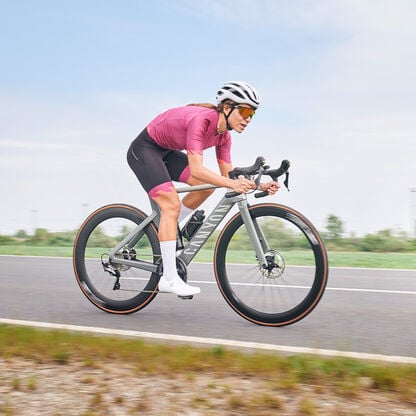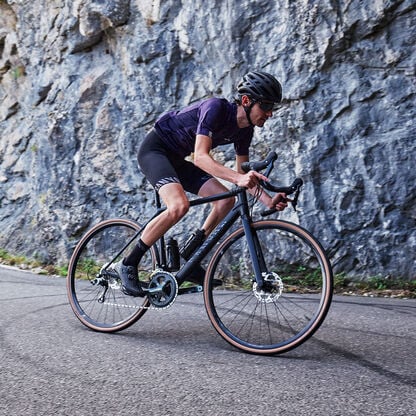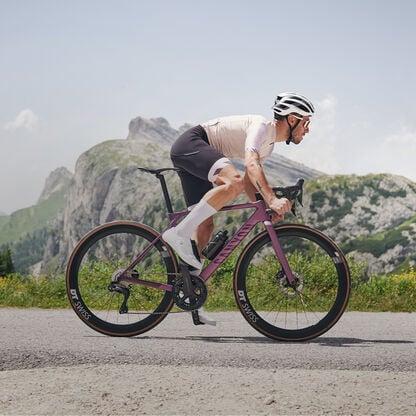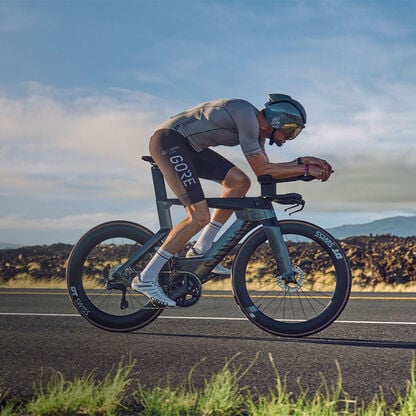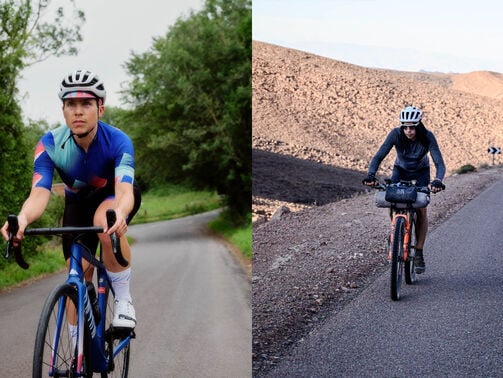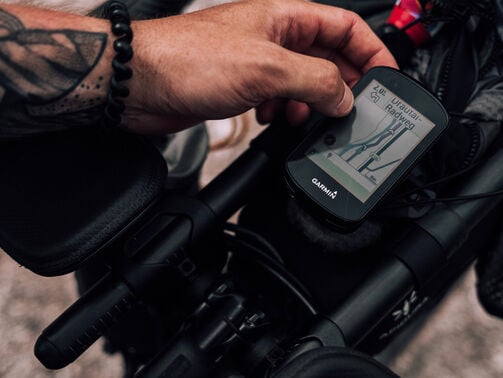How to choose a road bike: your ultimate buying guide
Discover everything our experts know about how to choose your next road bike, all in one comprehensive guide. We’ll explore different types of road bikes, explain how to find the perfect model for how you ride, and invest in a bike that you’ll love, season after season, year after year.


At Canyon we know that choosing the right road bike can be a bit overwhelming nowadays with so many options out there. From different road bike geometries and gearing to frame materials, tyre choices, and integrated features, there's a lot to consider.
But worry not – we'll help you navigate these choices to find the perfect bike for your riding style and budget.
Contents
How to choose a road bike: step one
First things first – your riding style and the terrain you'll be tackling are by far the most crucial factors when it comes to picking your road bike.
For example: if you're into long rides on rough gravel, there's no point in picking a finely balanced, highly efficient superlight road race bike as all that speed will just go to waste as soon as you leave the asphalt.
By the same token, if you're planning to compete in triathlons or road races where efficiency is critical, the rugged all-terrain capability of a bikepacking gravel bike will hold you back, with the knobbly off-road tyres and more relaxed, comfort-focussed geometry just slowing you down in a road race.
As a first step, then, start by forming a clear picture in your mind of exactly what kind of riding you’re most interested in doing.
- All-out road racing?
- Long, extended off-road tours?
- Or more specific sports, like cyclocross, time trials, or triathlon?
- Got a picture in your mind?
Great. Because once you know what kind of riding you want to do, then you’ve done most of the heavy lifting already.
From then on, it’s just a matter of:
- Identifying which Canyon road bike fits that vision
- Picking the right model for your budget
- And making sure you’re getting your bike in the right size
Let’s break it down.
Understanding road bike types and ride styles
When it comes to road bikes, there's a wide variety of designs designed to cater to different riding styles and preferences. The differences among these bikes come down to their geometry (the frame angles), materials, and specific design features.
Some bikes are highly agile and optimised for aerodynamics, making them perfect for racing – while others put you in a more relaxed upright position, ideal for extra comfort over long distances. Frame materials can range from lightweight carbon fibre to more robust aluminium, affecting both the bike's performance and price.
Understanding these distinctions is crucial when deciding on the right bike for your needs. Whether you're looking for speed, endurance, versatility, or a mix of all these, there's a road bike out there tailored for you. Let's dive into the most common road riding styles and the best bikes for them.
Road race bikes: built for speed
Designed for all-out speed on smooth asphalt, road race bikes feature lightweight aero frames to maximise efficiency. These bikes typically have more ‘pointy’, agile handling plus ‘aggressive’ geometries that put you in a lower, more horizontal position on the bike so you cut through the air with minimal resistance.
If you’re racing on the road or enjoy pushing your limits on your training rides and workouts, you need the Aeroad or the Ultimate.
Most of our pro road racers compete on the Aeroad – it’s the bike that Mathieu van der Poel won the Road World Championship on, and the most aerodynamically efficient bike in the pro peloton today. An all-out speed demon.
The Ultimate is our all-round race bike, especially cherished by our climbing specialists.
Endurance road bikes: long-distance comfort
If you’re more into covering big distances laid-back, in comfort but still nice and fast, you’ll want an endurance road bike like our Endurace.
With its more relaxed riding position, you’re more upright in the saddle and have less distance to reach forward – which reduces pressure on your arms, shoulders and back so you still feel nice and fresh even on long days on the road. It still feels plenty quick and has the hallmark precise, confident handling that Canyon road bikes are known for, while sacrificing a little of the high-end speed of its racing counterparts to keep you more comfortable.
Triathlon bikes: built for the bike split
Specifically designed for the demands of triathlon racing, tri bikes put maximum focus on aerodynamics, combining aero-optimised frame forms, deep-section aero wheels, and specialist cockpits that let you almost lay across the bike horizontally for maximum efficiency.
More advanced models also feature special design elements for internally carrying tools, nutrition, and hydration, making these vital aspects of the sport more convenient. These integrated storage solutions not only reduce drag but also ensure that athletes have easy access to their essentials during the bike split.
A multiple Triathlon World Championship winner in the hands of Sam Laidlow and Laura Philipp, the Speedmax is the ultimate triathlon bike.
Aerodynamically advanced, highly adjustable for the perfect fit, and featuring integrated solutions for simple, streamlined tool storage, and on-board hydration and nutrition. This is the bike to beat.
Time trials: all-out speed
Time trial bikes are specifically designed for maximum aerodynamic efficiency out on the road. In this aspect, they are similar to triathlon bikes. However, compared to triathlon bikes, they strip out tri-specific storage features because time trials are shorter.
Time triallists can also benefit from the Speedmax CFR’s World Championship-winning speed. 100% UCI compliant and fully adapted for time trialling – when seconds count, nothing comes close to the Speedmax CFR TT.
Track bikes: made for the velodrome
Track bikes are crafted for the smooth, banked surfaces of velodromes, stripping out all unnecessary components in the relentless pursuit of ultimate speed. With a single-speed, fixed gear setup and no brakes, these bikes embody simplicity and efficiency, allowing riders to achieve maximum velocity.
Developed by the world’s leading engineers, tested by the world’s premier athletes. The Speedmax CFR Track is built to beat the clock at the biggest races at velodromes around the world.
Featuring the best aerodynamics ever seen on a Canyon bike, a fully adjustable cockpit system for the ultimate in control and ergonomics, and fully optimisable for all track disciplines with swappable bars and wheels. This is a thoroughbred bike built for the track.
Cyclocross racing: optimised for the ‘cross course
Cyclocross bikes are engineered for the diverse and challenging terrain of cyclocross courses. With twitchy, agile handling for maximum manoeuvrability and increased tyre clearance to prevent mud buildup, these bikes are built to handle mud, grass, gravel, and obstacles, ensuring riders can navigate the course with speed and agility.
With a huge number Cyclocross World Championships to its name, the Canyon Inflite is the undisputed champion of cyclocross and the most decorated bike in the modern sport.
The choice of Mathieu van der Poel, It’s a bike optimised for ‘cross racing in every aspect. Mud-shedding tube profiles for fewer pit stops, cross-optimised geometry for dialled confident handling, special kinked seat tube for easier shouldering.
Canyon road bike models: pick the exact right one for you
Decided which design’s right for you?
Now it’s time to pick which exact model you need! Luckily, at Canyon we’ve got a logical naming system that makes it to make it a bit easier.
If you’ve browsed through a couple of our bikes, you’ll have seen that a typical Canyon bike name might read something like ‘Endurace CF SLX 8 Di2 Aero’ or ‘Endurace 6’, to use two examples.
This is what it all means.
What does the number in the name of Canyon road bikes mean?
In short – the higher the number in the name, the more premium the components.
In general it’s important to remember: even on our most affordable bikes, the standard of modern bike components is very high in terms of reliability and durability. That’s to say, even on an Endurace 6 you could ride across entire continents or around the entire globe (as long as you keep your bike well maintained and looked after).
However, on the higher-number bikes, the higher-quality components are significantly lighter, and feel more premium and more comfortable, which makes a major difference the more time you spend in the saddle.
Example of upgrades you’ll see at higher levels include things like electronic gear shifting, carbon wheels, more premium tyres – all feel awesome and we can promise that upgrading to parts like these gives you a major boost in terms of speed and comfort. BUT: functionally, remember it’s nothing you absolutely need to take on epic rides and love them.
What do CFR/CF SLX/CF mean?
In most cases, this refers to the frame material – CFR bikes using the world’s best carbon, CF SLX using high-end advanced carbon, and CF using high-quality carbon fibre. Of course, we tend to fit a higher spec of component onto the higher-end models.
| CFR | The choice of the pros: if a bike has CFR in the name, you know it’s the best of the best we can build. Raced by our pros, constructed from the highest grades of carbon fibre, and built out with the finest parts available on the market today. |
|---|---|
| CF SLX | Engineered perfection: CF SLX means championship-level performance at price point geared towards high-end amateur athletes. Superlight carbon frames are fractionally heavier than their CFR cousins, and we combine them with high-end components from the world’s leading manufacturers. |
| CF | Carbon for all: CF bikes take all our design mastery and carbon fibre expertise and makes it in available in our most accessible carbon bikes. These bikes typically feature the same frame dimensions as the high-end CFR and CF SLX models, with slightly less advanced carbon and medium-class components. |
| AL | Aluminium bikes – affordable, durable: if the bike name doesn’t have any of those in it, then it’s made from aluminium. Aluminium bikes are typically the most affordable in a bike range – and while lacking the prestige, elegance and lightness of their carbon counterparts, they’re more resistant to mechanical mishaps, and deal better with being dropped and exposed to rougher handling. |
Canyon road bike titles: what else to know?
Sometimes, you’ll see a bike name with an extra word or phrase added on the end – examples including ‘Di2’, ‘Aero’, ‘LTD’, or similar.
These words typically describe a standout feature or characteristic of the bike that makes it standout.
‘Di2’ and ‘AXS’ refer to the electronic shifting systems of Shimano and SRAM that they feature, ‘Aero’ means it has aero wheels when other similar options may not, and LTD refers to a limited edition with an especially high-end spec or featuring special edition parts.
We recommend reading the short description on a bike’s product page for a clear idea of what the standout features of one of these bikes is.
What else to look for when buying a road bike
Down to picking between your last few bike models?
Now, it comes down to the fine details – the frame material and components. These are the main things to look out for.
Road bike frame materials explained
The main two frame materials for Canyon road bikes are carbon fibre and aluminium.
Carbon frames are more lightweight and stiff, offering excellent responsiveness and comfort by absorbing road vibrations. However, they are more expensive and can be prone to cracking under impact.
Aluminium frames are more affordable and durable, with better resistance to impact damage. They are heavier and provide a harsher ride due to less vibration absorption.
Road bike drivetrain and groupset options:
That’s the fancy name for the entire gearing system – the chain, the cassette (the cogs on the rear wheel), the derailleurs (the devices that change gears) and the chainring, meaning the front cog that you crank with your pedals.
There are two main design choices to consider here:
- if you want modern electronic gear shifting or traditional mechanical gear shifting,
- and if you want a single-chainring one-by setup, or double-chainring two-by setup.

Understanding gear shifting for road bikes
Electronic shifting systems give you instant, flawless shifting, and most riders find them easier to adjust and set up compared to mechanical systems. However, they are more expensive than their mechanical equivalents, and replacement parts are more expensive. They typically have names like AXS or Di2.
Mechanical shifting systems are cheaper than electronic systems. They shift well for season after season, but if you’re looking for the cleanest, most rapid and precise shifting around, they don’t quite match up to their electronic counterparts.
One-by vs two-by chainrings
A one-by setup features a single chainring at the front, simplifying the drivetrain and reducing weight. This setup is ideal for riders who prefer a straightforward, low-maintenance system and often ride on varied terrain where finding the perfect gear ratio to lock into a specific leg pedalling (also known as cadence) is less critical.
A two-by setup includes two chainrings at the front. This setup is beneficial for riders who need more versatility, such as road cyclists who require precise gear changes to maintain optimal pedalling speed. While a two-by system is slightly more complex and heavier than a one-by, it provides more options for fine-tuning your gear ratios.
Road bike wheels and tyres: what to look for
Do you want carbon wheels, or aluminium wheels? This is a matter of performance versus cost.
Carbon wheels are stiffer, lighter, and more aero than aluminium wheels – in short, they offer superior performance across the board. They also just feel fast, giving you a thrilling sense of speed and efficiency. However, they come at a higher price and can be more fragile.
On the other hand, aluminium wheels are more affordable, durable, and easier to repair. They might not offer the same level of performance as carbon wheels, but they are a great choice for everyday riding and training.
In terms of tyre choice, most of our road bikes come with fast-rolling slick tubeless-compatible tyres – the optimal choice for road riding. We make tweaks based on intended ride style of the bike, with Endurace models rolling on wider, more plush 32 mm rubber and our cyclocross bikes coming with 33 mm cyclocross-specific tyres.
Choosing the right road bike size
It’s a common worry we hear all the time: when buying their bike online, some riders are concerned they might choose the wrong size, ending up with a bike that fits poorly.
However, we can confidently say that nothing could be further from the truth.
To make sizing quick, easy and intuitive, we've developed our own bike sizing tool called the Perfect Positioning System (PPS). All you need to do is take two basic measurements – your height and your inner leg length – and dial them into the PPS tool.
The whole process takes about 5 minutes, and when you’re done, we’ll give you a tailored size recommendation for any Canyon bike you're interested in.
The tool uses over 15,000 data points to determine your perfect frame size, and it also recommends a seat height range. And it checks to make sure the bike you're browsing can accommodate your seat height. We've found that 98% of people, when inputting correct data, will receive their ideal frame size using our tool.
Once you've entered your measurements, you'll see your recommended frame size on each bike's page. And if the worst happens, and your bike doesn't fit, you can return it us within 30 days for a full refund (Still unsure? Check out our guide for tips and advice on how to find your perfect road bike size).
Road bike roundup
That’s everything we think you need to know to make an informed, confident decision on which bike is the right one for you.
To recap:
- Decide on what kind of riding you want to do
- Use our pointers above to find out which is the right bike for your ride style
- Figure out what level of bike fits your ambitions
- Pick out the exact model based on which component spec fits your needs
- Get the right size using our PPS tool
If you need some more inspiration on the best road bikes for beginners, check out our helpful guide here.
Aaand… that’s it – enjoy the ride on your new Canyon dream bike🤙!

Discover our Road Bikes
Did this article help?
Thank you for your feedback

